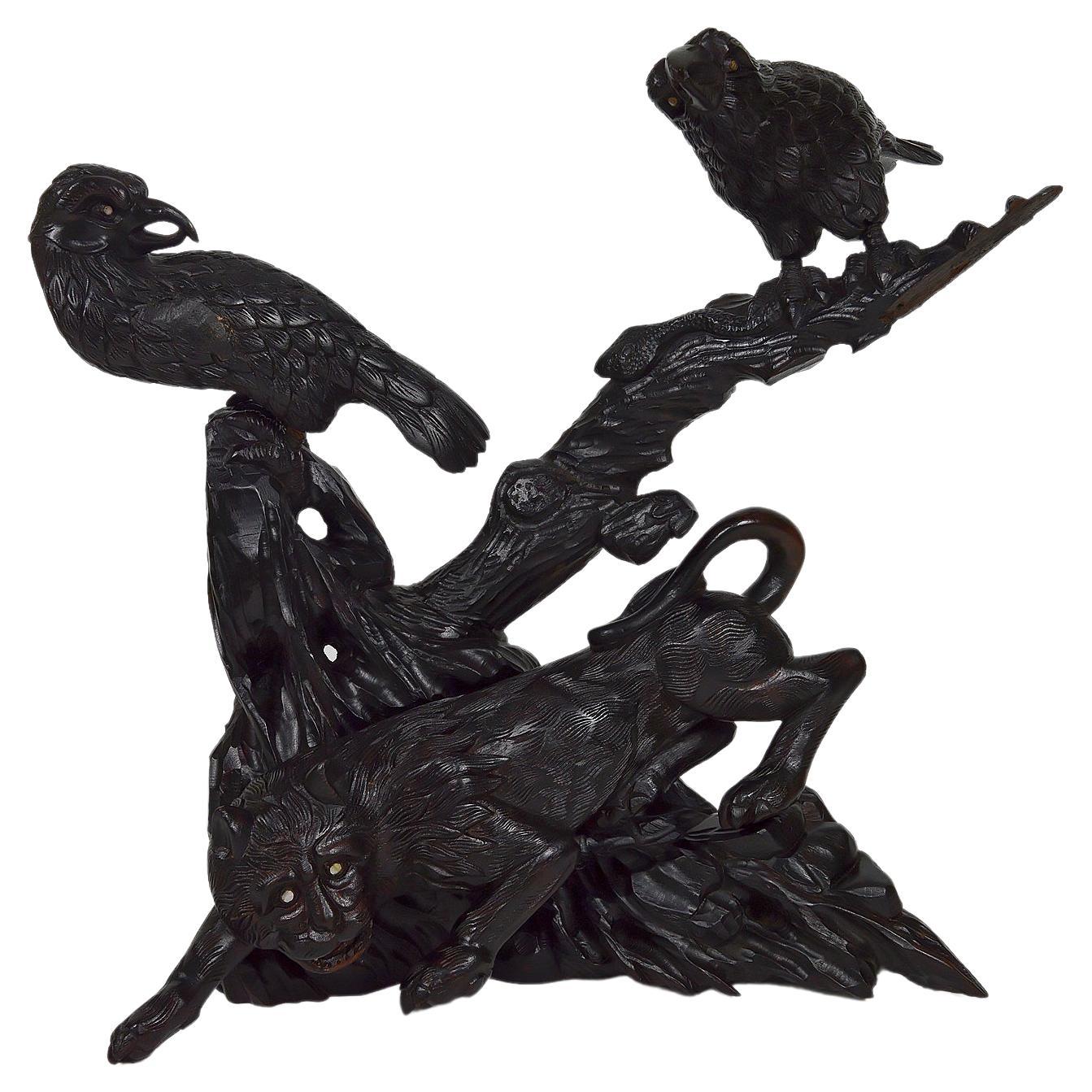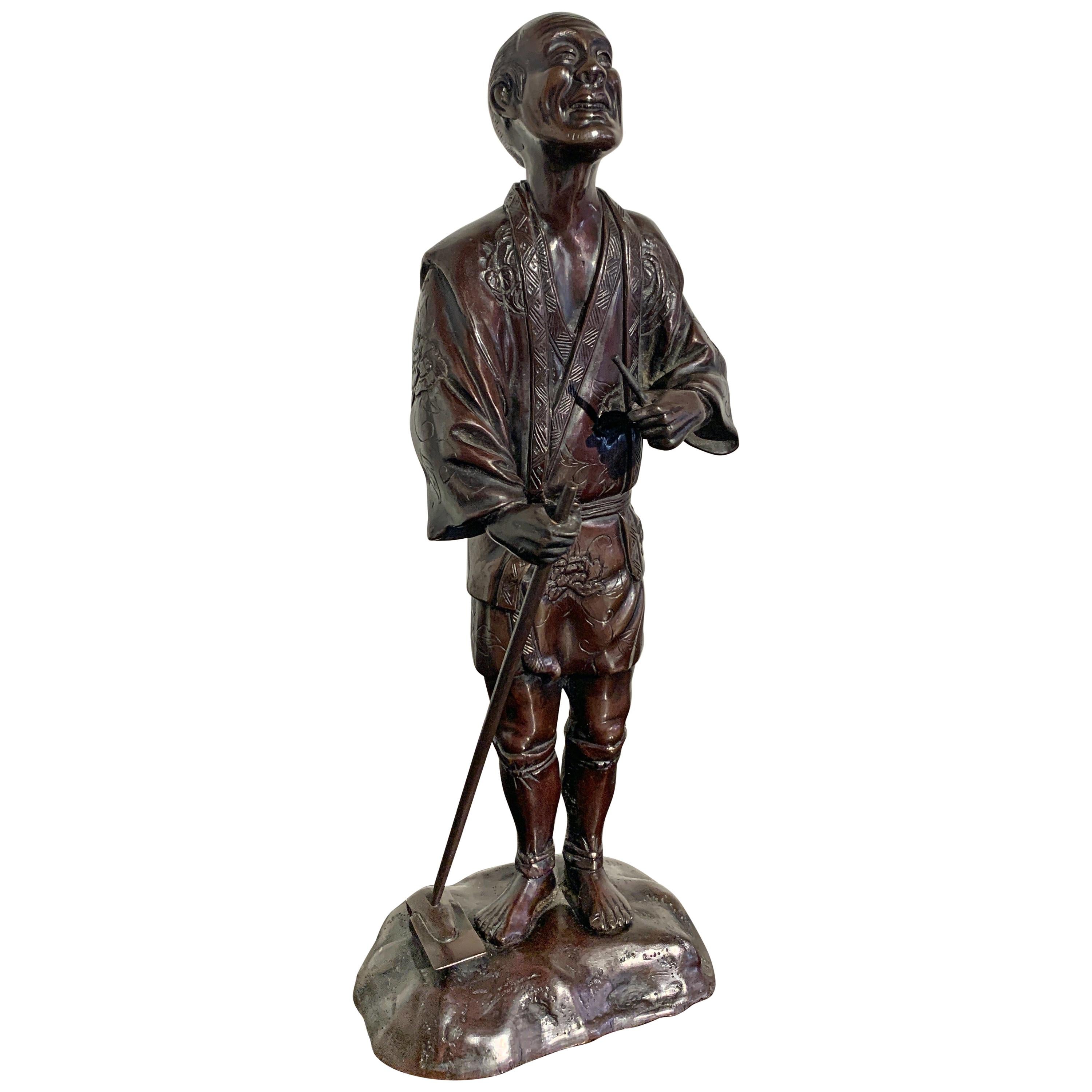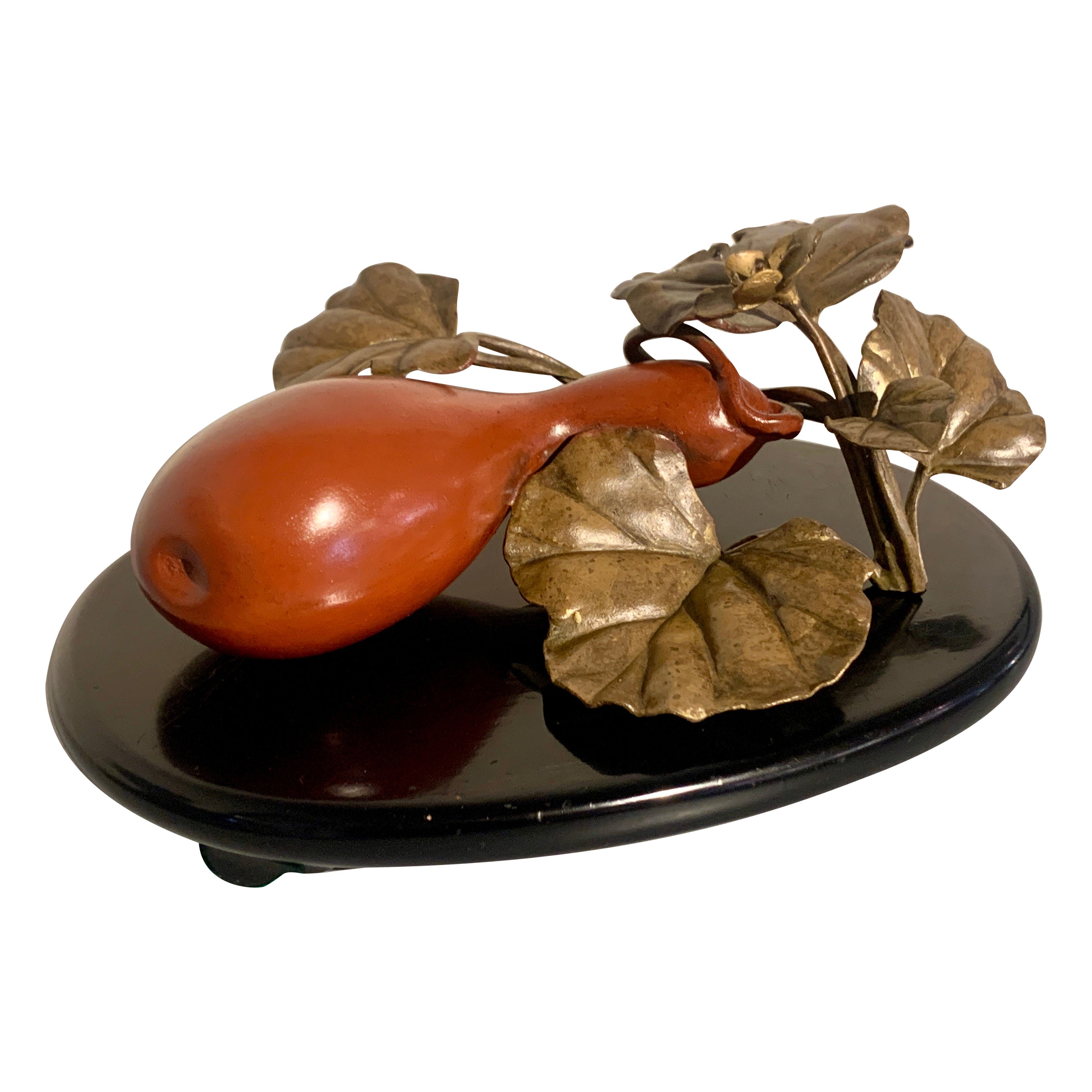Items Similar to Ivory Okimono by Kofu, Japan Meiji era
Want more images or videos?
Request additional images or videos from the seller
1 of 17
Ivory Okimono by Kofu, Japan Meiji era
About the Item
Rare okimono carved in the thickness of an elephant tusk depicting a life-size pigeon. It stands on a hollow trunk, inside which hides an owl.
A small 4mm lack at the end of the tail and the beak probably restored, unless it is a natural crack in the ivory.
This sculpture is the masterpiece of master Ko Fu of the Tokyo school.
Japan, late 19th century.
ps : Cites will be requested at time of sale
Please note that this item cannot be sold in the United States !
- Dimensions:Height: 9.65 in (24.5 cm)Width: 7.09 in (18 cm)Depth: 7.09 in (18 cm)
- Style:Meiji (Of the Period)
- Materials and Techniques:
- Place of Origin:
- Period:
- Date of Manufacture:circa 1880
- Condition:Minor losses.
- Seller Location:Saverne, FR
- Reference Number:1stDibs: LU8536237866222
About the Seller
5.0
Vetted Seller
These experienced sellers undergo a comprehensive evaluation by our team of in-house experts.
1stDibs seller since 2023
6 sales on 1stDibs
Typical response time: 5 hours
- ShippingRetrieving quote...Ships From: Saverne, France
- Return PolicyA return for this item may be initiated within 3 days of delivery.
More From This SellerView All
- Okimono - Bronze Sculpture By Kakuha Kanzaemon, Japan Meiji EraLocated in Saverne, Grand EstSuperb bronze okimono with black patina representing a peasant resting after his work, a basket of vegetables at his feet. Signed Kakuha Sei on the wooden stump. Excellent quality ! ...Category
Antique Late 19th Century Japanese Meiji Sculptures and Carvings
MaterialsBronze
- Okimono - Bronze Sculpture by Genryusai Seiya, Japan Meiji EraLocated in Saverne, Grand EstSuperb bronze okimono with dark brown patina representing a lady holding a gourd in her left hand. Signed Seiya Sei (made by Seiya). Genryusai Seiya was a master craftsman specializi...Category
Antique Late 19th Century Japanese Meiji Metalwork
MaterialsBronze
- Okimono - Bronze sculpture of a puppy, by Munechika, Japan Meiji EraLocated in Saverne, Grand EstCharming bronze okimono depicting a sitting puppy raising its paw and looking into the distance. High quality, highly detailed sculpture, the eyes inlaid with gold and shakudo. Signe...Category
Antique Late 19th Century Japanese Meiji Metalwork
MaterialsBronze
- Okimono - Bronze Sculpture of a chinese / japanese puppy, Japan Meiji EraLocated in Saverne, Grand EstExtraordinary bronze okimono with dark brown patina representing a Japanese Chin playing with a ball. High-quality work executed by a master craftsman, e...Category
Antique Late 19th Century Japanese Meiji Metalwork
MaterialsBronze
- Okimono - Sculpture : Elephant attacked by tigers, by Mitsumoto, Japan Meiji EraLocated in Saverne, Grand EstMagnificent composition for this bronze okimono with double patina representing an elephant attacked by two tigers. The skins of the different animals are rendered with great detail ...Category
Antique Late 19th Century Japanese Meiji Metalwork
MaterialsBronze
- Okimono - Bronze Sculpture Of An Eagle, Japan Meiji EraLocated in Saverne, Grand EstRare bronze okimono with multiple patina representing a bird of prey perched on a hollow trunk. This sculpture is astonishingly realistic : observe the somewhat crude appearance of t...Category
Antique Late 19th Century Japanese Meiji Metalwork
MaterialsBronze
You May Also Like
- Asian Sculpture / Okimono with Lion and Crows, Japan, Meiji Era, circa 1880Located in VÉZELAY, FRRare and important Japanese sculpture / statue / okimono in blackened and carved wood, depicting 1 lion, 2 birds (crows or other birds of prey) and 1 snake held in the claws of one o...Category
Antique 1880s Japanese Meiji Sculptures and Carvings
MaterialsWood
- Japanese Meiji Period Carved Wood Okimono Man with RabbitsLocated in Newark, EnglandThe charming figure, carved from a single piece of wood is exceptionally carved showing the male figure with humorous expression holding two Rabbits one by the ears and the second under his arm. A third Rabbit stands at the feet of the male looking up, each rabbit with a different expression. The male figure is wearing traditional Japanese attire with his hair tied back stood upon a naturalistic base. The figure dates to the Meiji Period (1868-1912) circa 1900. Notes The Rabbit is one of the 12 animals to feature in the Japanese Zodiac signs which follows the Chinese astrological system along with the Rat, Ox, Tiger, Rabbit, Dragon, Snake, Horse, Goat, Monkey, Rooster, Dog, Pig. Such division is connected with the Jupiter cycle around the Sun, which lasts about 12 years. As 2023 is the year of the Rabbit...Category
Antique Early 1900s Japanese Meiji Sculptures and Carvings
MaterialsWood
- Japanese Tokyo School Bronze Okimono of a Farmer, Meiji PeriodLocated in Austin, TXA very fine and detailed Tokyo School cast bronze okimono (decorative sculpture) of a smiling farmer, Meiji period, late 19th century, Japan. The e...Category
Antique Late 19th Century Japanese Meiji Sculptures and Carvings
MaterialsBronze
- Japanese Meiji era chestnut netsukeLocated in PARIS, FRWooden netsuke featuring a group of three chestnuts. One of them reveals a tiny hole and the head of a small worm in bone inlay, offering a very naturalistic representation. Chestnu...Category
Antique Late 19th Century Japanese Japonisme Sculptures and Carvings
MaterialsBoxwood
- Japanese Painted Bronze Okimono of a Gourd by Toyo, Showa Era, 1960s, JapanBy ToyoLocated in Austin, TXA charming Japanese decorative bronze sculpture, okimono, of a gourd, hyotan, by Toyo Japan, Showa Era, circa 1960s, Japan. The realistic okimono, fashio...Category
Vintage 1960s Japanese Showa Sculptures and Carvings
MaterialsBronze
- Japan 1890 Meiji Period Signed Okimono Sculpture of a Group of Skeletons SmokingLocated in Miami, FLSculptural signed Okimono from the Japanese Meiji period (1868-1912). Very rare, unusual and large sculptural assembling of a dysplaying piece of okimono. Created in Japan during the imperial period of the Meiji (1868-1912). This extraordinary okimono was carefully carved depicting a group of three intricately and realistically rendered carousing skeletons (Gaikotsu) in relax and resting position, drinking and smoking. Two of them, probably males representations are resting on a wicker sofa. The third, is a woman seated in a lower stool offering drinking cups of sake on a round tray. A small rectangular bench is arranged in the scene. The composition is displayed on a four-legged carved wood platform with an inlaid red plaque engraved with the artist's signature. The level of detail and the quality of the carving is truly exceptional. Has an exact measurements of 209.55 mm by 196.85 mm by 127.76 mm (8.25 x 7.75 x 5.03 Inches). After an extensive collection of data, comparables and references to this piece, we have only been able to find only three okimono sculptures like this with similar themes and the same quality of work. References Note: A similar carving of four skeletons playing an animated game of dominos, signed Shutaro in an inlaid rectangular red plaque, was sold in London by Christie’s South Kensington in October 14 2014, Lot 120 Sale 5546. References Note: A similar carving with four skeletons in an otherwise typical victorian scene of a photographer and three sitters signed Shutaro in an inlaid rectangular red plaque, was sold in Edinburgh at Lyon & Turnbull in November 7, 2018. References Note: A similar carving with five skeletons seated, playing cards and drinking, was sold in London by John Nicholson Fine Art on September 26, 2018. Meiji period, is an era of Japanese history that extended from October 23, 1868 to July 30, 1912. The Meiji era was the first half of the Empire of Japan, when the Japanese people moved from being an isolated feudal society at risk of colonization by Western powers to the new paradigm of a modern, industrialized nation state and emergent great power, influenced by Western scientific, technological, philosophical, political, legal, and aesthetic ideas. As a result of such wholesale adoption of radically different ideas, the changes to Japan were profound, and affected its social structure, internal politics, economy, military, and foreign relations. The period corresponded to the reign of Emperor Meiji. It was preceded by the Keio era and was succeeded by the Taisho era, upon the accession of Emperor Taisho. Okimono, is a Japanese term meaning for display an ornament; art object; or decorative object, usually displayed in a tokonoma or butsudan "Buddhist altar". It is an ornament or figure, especially one placed in a guest room. An okimono may be a small Japanese...Category
Antique 1890s Japanese Meiji Sculptures and Carvings
MaterialsWood
Recently Viewed
View AllMore Ways To Browse
Japanese Inro Netsuke
Shans Long
Pp 250
1800s Black Buddha Statue
Gilded Antique Wood Carving
Sandstone Chinese Figures
Asian Puppet Head
Gilded Wood Carving
17th Century Antique Lantern
17th Bronze Buddha
15th Bronze Buddha
Vintage Large Lantern Post
Japanese Jin Chan Money Frog
Naruko Kokeshi
Asian Seat
Buxton Watch
Carved Coral Statue
Kimono Display Stand





